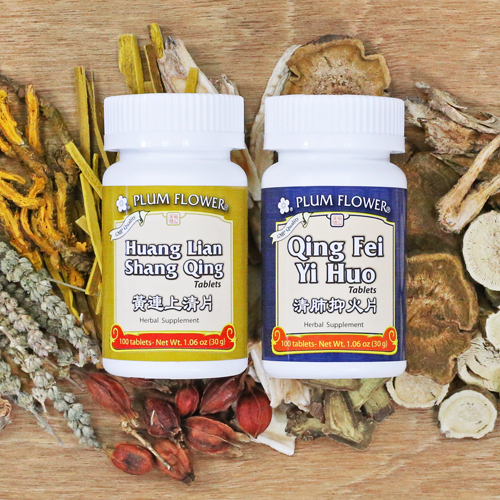Renewed Formulas: Qing Fei Yi Huo & Huang Lian Shang Qing
Two Famous Formulas are Back!
Mayway Herbs is pleased to announce the return of two important formulas that were discontinued nearly 10 years ago due to licensing issues in China. These renewed formulas are now being made by our joint-venture facility, Hebei-Meiwei Pharmaceutical Co. in Anguo, Hebei Province. Importantly, these formulas are manufactured according to our quality specifications including the use of our sulfite-free herbs.
Qing Fei Yi Huo Pian

Plum Flower Qing Fei Yi Huo Pian (MW# 3917) was formerly named Ching Fei Yi Huo Pien, using Wade-Giles romanization. The name literally means “Clear the Lungs and Restrain Fire Tablets” and this name defines at least one of the primary functions of this formula. The formula dates from the early 17th century.
Qing Fei Yi Huo Pian clears Lung Heat, reduces Fire, reverses the failure of the Lung Qi to descend, generates and restores body fluids, and promotes the descent Large Intestine Qi to remove obstruction in Yang Ming organ syndrome.
This formula is indicated when there is Lung Heat or Lung Fire, and the Lung Qi fails to descend. This symptom can be loud or barking and causing discomfort in the chest, with or without phlegm, which may be difficult to expectorate. There may be other typical signs of Fire, especially showing up in the areas of the Yang Ming channel in the face. Yang Ming organ syndrome results from the Fire in the Lungs impairing the Lungs function of disseminating fluids resulting in acute dryness in the Large Intestine which may result in impacted or obstructed stool (便秘 biàn mì), abdominal discomfort, and thirst. Often, patients will be prone to recurrent episodes following an acute Wind Cold or Wind Heat invasion, with the symptoms repeatedly lodging in the same part of the upper respiratory tract, the lungs, throat, or sinuses. The tongue shows signs of Heat or Fire and appears red, with a red tip and a dry yellow coating. The pulse is full, rapid, and perhaps, surging.
Qing Fei Yi Huo Pian Ingredient Functions
Huang qin / Scutellaria baicalensis root is bitter and cold. It clears Heat, dries Dampness in the Stomach and Intestines, and resolves toxicity in the Upper Jiao.
Zhi zi / Gardenia jasminoides fruit is bitter and cold. It is used to clear Heat and purge Fire.
Da huang / Rheum palmatum root is bitter and cold. It drains Heat and Fire, transforms Dampness, and purges clumped heat in the Intestines.
Qian hu / Peucedanum praeruptorum root is bitter, pungent, and slightly cold. It is used to descend the Lung Qi, direct Fire downward, and dispel Phlegm.
Ku shen / Sophora flavescens root is bitter and cold. It clears Heat and dries Dampness in the Lower Jiao.
Tian hua fen / Trichosanthes kirilowii root is bitter, slightly sweet, and cold. It is used to cool Lung and Stomach Heat, generate body fluids, transform Phlegm, and nourish Lung Yin.
Jie geng / Platycodon grandiflorum root is pungent and slightly warm. It opens and disseminates the Lung qi, dispels Phlegm, and guides the action of the formula to the Upper Jiao.
Zhi mu / Anemarrhena asphodeloides rhizome is bitter, sweet, and cold. It clears Heat, purges Fire, and nourishes the Yin of the Lung, Kidney and Stomach.
Tian hua fen and Zhi mu work together to tonify fluids in aftermath of a Warm Evil Qi invasion.
Cautions and Contraindications: Contraindicated during pregnancy and menstruation. Use with caution in breast-feeding women as Da huang can pass through the breast milk causing colic and diarrhea in infants. Contraindicated for weak or deficient patients. Not recommended for children under five years old. This is a bitter and cold formula which can easily damage the Spleen and Stomach Qi. May cause diarrhea and/or abdominal cramping.
Administration: 4 tablets daily for up to 3 consecutive days. Administer half an hour before or one hour after eating. In severe cases dosage may be increased to 4 pills twice daily for up to seven days. Once acute heat signs are resolved, this formula should be discontinued, and replaced with a milder formula.
Huang Lian Shang Qing Pian
Plum Flower Huang Lian Shang Qing Pian (MW# 3950) was formerly named Huang Lien Shang Ching Pien, using Wade-Giles romanization. The name literally means “Coptis Upper Clear Tablets” and this famous formula is known for its ability to clear the upper burner of Heat and Toxins. The formula dates from the late 16th century.
Huang Lian Shang Qing Pian dispels Wind Heat, clears Heat and Toxins, purges Fire, clears Damp Heat from the upper body, cools the Blood, clears Heat from the Yang Ming, and unblocks the bowels.
Huang Lian Shang Qing Pian is indication for Upper Jiao Wind Heat and Toxic Heat presenting with symptoms appearing in areas of the head corresponding to the Foot and Hand Yang Ming channels and various skin conditions due to Heat or Fire Evil Qi.
Additionally, it may prove helpful for Wind Heat or Liver Fire uprising in the Liver and Gallbladder channels presenting with symptoms in areas of the head corresponding to the Foot Shao Yang channel. Huang Lian Shang Qing Pian is also indicated for Heat in the Stomach and Yang Ming channel and organ system presenting with impacted or obstructed stool (便秘 biàn mì). The tongue shows signs of Heat and appears red, with a yellow coating. The pulse is full, rapid, and perhaps, floating and maybe the most notable in the cun position.
Huang Lian Shang Qing Pian Ingredient Functions:
Da huang / Rheum palmatum root is bitter and cold. It drains Heat and Fire, transforms Dampness, and purges clumped heat in the Intestines.
Man jing zi / Vitex trifolia fruit is cool, bitter, and pungent. It disperses Wind, clears Heat, and benefits the head and eyes.
Ju hua / Chrysanthemum morifolium flower is sweet, bitter, and slightly cold. It disperses Wind, clears Heat, calms the Liver, and clears the eyes.
Huang lian / Coptis chinensis rhizome is bitter and cold. It cools Heat, drains Stomach Fire, and dries Dampness.
Jing jie / Schizonepeta tenuifolia herb is pungent and slightly warm. It releases the Exterior for either Wind Heat or Wind Cold.
Dang gui / Angelica sinensis root is sweet, pungent, and warm. It is used in this formula to moisten the Intestines and unblock the bowels.
Jie geng / Platycodon grandiflorum root opens and disseminates the Lung qi, dispels Phlegm, and guides the action of the formula to the Upper Jiao.
Huang qin / Scutellaria baicalensis root is bitter and cold. It clears Heat, dries Dampness in the Stomach and Intestines, and resolves toxicity in the Upper Jiao.
Fang feng / Ledebouriella divaricata root is sweet, pungent, and slightly warm. It releases the Exterior and expels Wind Cold and Wind Dampness.
Shi gao / Gypsum fibrosum mineral is sweet, pungent, and very cold. It clears Heat and drains Fire, especially from the Yang Ming organs and channels.
Chuan xiong / Ligusticum wallichii rhizome is pungent and warm. It promotes the movement of Qi and Blood and expels Wind.
Gan cao / Glycyrrhiza uralensis root is sweet and neutral/ It clears Heat and resolves Fire while moderating and harmonizing the other herbs in the formula.
Cautions and Contraindications: The configuration of purgative and cooling herbs makes it appropriate for short-term use only. Contraindicated during pregnancy and menstruation. Use with caution in breast-feeding women as Da huang can pass through the breast milk causing colic and diarrhea in infants. Not recommended for children under five years old. Contraindicated for weak or deficient patients. This is a bitter and cold formula which can easily damage the Spleen and Stomach Qi. May cause diarrhea and/or abdominal cramping.
Administration: 4 tablets daily for up to 3 consecutive days. Administer half an hour before or one hour after eating. In severe cases dosage may be increased to 4 pills twice daily for up to seven days. Once acute heat signs are resolved, this formula should be discontinued, and replaced with a milder formula.
References:
- Bensky, D. et al., Chinese Herbal Medicine Materia Medica, 3rd ed., Eastland Press: 2004.
- Chen, J. & Chen, T., Chinese Medical Herbology and Pharmacology, Art of Medicine Press: 2004.
- Fratkin, J., Chinese Herbal Patent Medicines: The Clinical Desk Reference, Shya Publications, 2001
- Maclean, Will, Clinical Manual of Chinese Herbal Patent Medicines, Pangolin Press: 2003
 Bio: Skye Sturgeon, DAOM Bio: Skye Sturgeon, DAOMSkye is the Quality Assurance Manager and Special Consultant for Mayway, USA. Skye was the former Chair of Acupuncture & East Asian Medicine and core faculty member at Bastyr University, core faculty member and Faculty Council Chair at the American College of Traditional Chinese Medicine, and President and Senior Professor of the Acupuncture & Integrative Medicine College, Berkeley. Before making Chinese medicine his career choice, Skye held various positions in the Natural Foods Industry for 12 years and prior to that was a clinical biochemist and toxicologist. |

